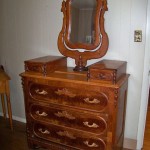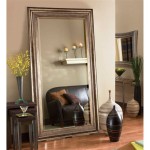French Gilt Mirrors: A Reflection of Elegance and History
French gilt mirrors represent a significant segment of decorative arts, embodying centuries of craftsmanship and evolving aesthetic sensibilities. Their enduring appeal lies in the combination of opulent ornamentation, reflective brilliance, and a palpable connection to French history and culture. From grand palaces to intimate salons, these mirrors have played a crucial role in shaping interior design and reflecting societal trends.
The term "gilt" refers to the application of gold leaf or gold paint to a surface. In the context of French mirrors, gilding transforms the frame from a simple structural element into a work of art. The process, traditionally intricate and time-consuming, involves meticulously applying thin sheets of gold leaf to a prepared surface, often carved wood or gesso. The resulting finish radiates warmth and luxury, adding depth and richness to the reflective surface of the mirror.
The history of French gilt mirrors is closely intertwined with the patronage of the French monarchy and aristocracy. During the reign of Louis XIV, the "Sun King," the production of luxury goods, including mirrors, reached new heights. The royal manufactory at Saint-Gobain, established in 1665, became a center for mirror production, contributing significantly to the development of advanced glassmaking techniques. This period saw the emergence of the iconic "trumeau mirror," a large, vertical mirror often placed between windows to maximize natural light and create an illusion of spaciousness.
The styles of French gilt mirrors have varied considerably across different periods, reflecting the prevailing artistic and decorative trends. The opulent Baroque and Rococo styles, popular during the 17th and 18th centuries, are characterized by elaborate ornamentation, featuring intricate carvings of acanthus leaves, shells, scrolls, and floral motifs. These mirrors often incorporated rocaille, a decorative style featuring asymmetrical shell-like and rock-like forms.
The Neoclassical period, which emerged in the late 18th century, witnessed a shift towards greater simplicity and symmetry in design. Neoclassical gilt mirrors often feature straight lines, geometric patterns, and classical motifs such as urns, swags, and laurel wreaths. The emphasis on clean lines and restrained ornamentation reflected the renewed interest in ancient Greek and Roman art and architecture.
The 19th century saw the continued production of gilt mirrors in a variety of styles, including revivals of earlier periods such as the Louis XV and Louis XVI styles. The development of new manufacturing techniques, such as electroplating, made gilding more accessible and affordable, leading to a wider availability of gilt mirrors among the burgeoning middle class.
The value of a French gilt mirror is determined by a number of factors, including its age, style, condition, and provenance. Antique mirrors from the 17th and 18th centuries, particularly those with documented royal or aristocratic provenance, can command significant prices at auction. The quality of the gilding, the intricacy of the carving, and the presence of original glass are also important considerations.
Identifying authentic antique French gilt mirrors requires careful examination and a discerning eye. Key indicators of age and authenticity include the type of wood used, the construction techniques employed, and the style of the carving. Wear and tear consistent with age, such as minor imperfections in the gilding or slight foxing on the mirror plate, can also be indicative of authenticity, adding to the mirror's character and value. Consulting with a reputable antiques dealer or appraiser is recommended for accurate authentication and valuation.
Caring for French gilt mirrors requires specific attention to preserve their delicate beauty. Dusting should be done with a soft, dry cloth, avoiding abrasive cleaners or polishing agents that can damage the gilding. Excessive humidity and direct sunlight should be avoided, as they can cause the gilding to tarnish or the wood to warp. For significant damage or restoration, consulting a professional conservator is essential to ensure appropriate treatment and maintain the mirror's historical integrity.
French gilt mirrors continue to be sought-after objects, prized for their ability to enhance interior spaces with a touch of historical elegance. Whether incorporated into a traditional or contemporary setting, these mirrors serve as both functional objects and decorative focal points, reflecting not only the surrounding environment but also the rich history and artistic heritage of France.
The enduring popularity of French gilt mirrors speaks to their timeless appeal and their ability to transcend fleeting trends. They remain a testament to the enduring power of craftsmanship, artistry, and the human desire to surround oneself with beauty and elegance.

Antiques Atlas Original Antique French Gilt Mirror As111a1039

Large 19th Century French Gilt Mirror Mi9029101 Lorfords Antiques

18th Century French Gilt Mirror Mi1430277 Lorfords Antiques

An Absolutely Stunning Large Antique French 19th Century Carved Wood Gesso Original Gilt Mirror 797220 Ingantiques Co

Large 19th Century French Gilt Mirror

Large Oak Leaf Gold Gilt Mirror Ornate Classic French Style In Distressed

19th Century Antique French Gilt Mirror Vintage Boathouse

French Gilt Mirror 25x46h Scissortail Marketplace

Large French 19th C Gilt Mirror Designs Antiques

The Drill Hall Emporium Antiques Tasmania French Gilt Mirror C 1860 Sold








